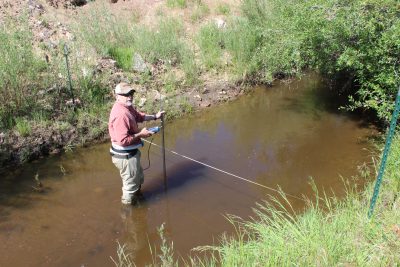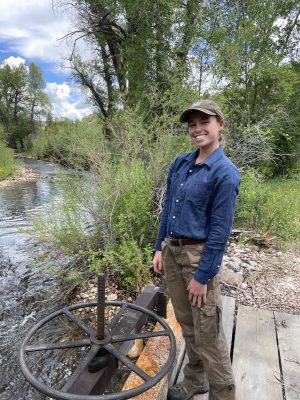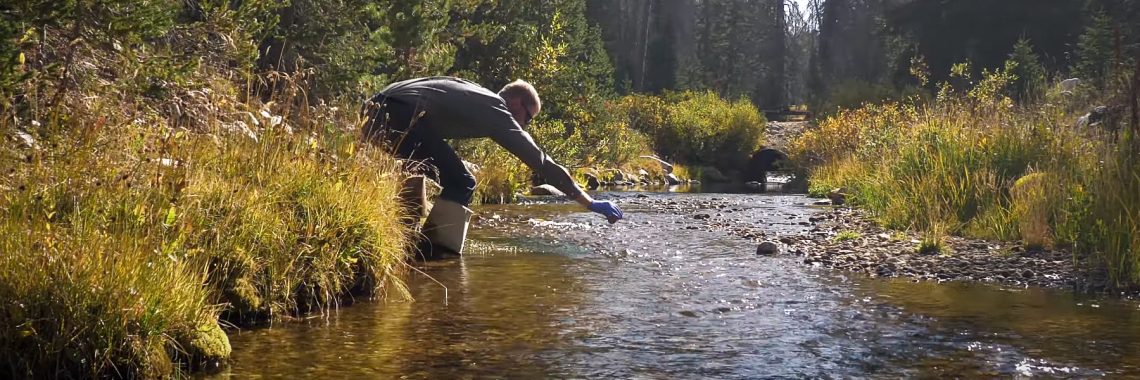Wyoming rancher, veterinarian, and legislator Kurt Bucholz was what his wife describes as a “water guy.” He believed in allocating irrigation water according to statutes, not squabbles.
Today, his neighbors in the Brush Creek watershed work with irrigation administrators from the University of Wyoming to do exactly that.
But it wasn’t always that way. Located in the North Platte River Valley, Brush Creek is the sixth largest irrigation district in Wyoming. It’s also known as one of the state’s most complex and conflict-ridden irrigation systems.
Bucholz’s efforts to better understand the more than 200 water rights associated with the drainage–and make that information available to his fellow ranchers—paved the way for a new, more constructive approach to water management. Over the past decade, his neighbors have stepped up, at first warily, and now more readily, to work together with the support of UW irrigation administrators.
“This is how I think Kurt would’ve liked to see it happen. We based it on that, being able to work together and manage things properly,” says his wife, Laura Bucholz.

While her husband passed away in 2006, she has carried on his legacy through her involvement with the Brush Creek project and generous support of UW’s water management research. In recognition of her contributions, she received the UW College of Ag’s 2023 Legacy Award.
Water wars
A fixture in the Saratoga ranching community, Kurt Bucholz began spending summers on the XH Ranch in 1957. In 2002, he was elected to the Wyoming House of Representatives as a representative of Carbon County.
In addition to his service to the state, Bucholz sought to alleviate longstanding tension over water rights in his home watershed. In 2002, he commissioned former Wyoming legislator Jeb Steward to research water rights in the Brush Creek drainage.
Steward created a booklet that irrigators could use to calculate water priorities according to state law. It was the first step in a long journey toward an innovative, science-based model developed by researchers at the University of Wyoming.
“Laura’s husband was the backer of the initial stages of research on irrigation in the Brush Creek drainage,” says Joe Cook, an irrigation administrator and UW research scientist. “If he hadn’t done that, there wouldn’t have been stepping stones to launch the project. That morphed into Laura being a staunch supporter of collaboration and keeping the group [of Brush Creek irrigators] together.”
Keeping the group together was not an easy task. For years, ranchers in the Brush Creek drainage could agree on only one thing: They needed help mitigating the constant conflict over water rights.
“Before the program that we have going on now, we spent more time fighting with each other and threatening lawsuits and arguing than we did actually irrigating with the water,” recalls rancher Michael Condict, who serves as ranching group coordinator for the Brush Creek – French Creek irrigation system.

In 2013, the conflict escalated beyond the state engineer’s office to the governor’s office. Finally, UW scientists were enlisted to assist with irrigation administration.
From conflict to cooperation
Building on Steward’s research, the UW researchers compiled baseline flow data and created a model to calculate water priorities at different flow rates. With the help of ranchers like Reggie Thornborg, whose institutional knowledge was key to the program’s success, the scientists translated data into physical adjustments throughout the system.
Today, the calculations are semi-automated and the 15 ranches participating in the program have access to real-time data online. During irrigation season, UW administrators monitor and adjust flow multiple times a day to ensure the correct volume of water goes to the correct locations in the correct order. “It’s never going to be perfect,” says Cook, “But we can make it as good as possible.”
This summer, a large ditch blew out in the Brush Creek drainage. In the past, irrigators whose water rights weren’t affected would’ve stayed home.
But that’s not the case anymore. “Everyone, whether they had a water right or not, came together and got it back online, saving time and money and creating a lot of goodwill,” says Laura Bucholz.
She’s hopeful that this neighborliness, absent for so long, will persist. “I think everyone feels good enough about how things work that it will carry on, hopefully for the next generation,” she reflects. “It’s like we want to carry on for Kurt and for Reggie.”
Supporting irrigation excellence
What started as a tentative truce between feuding neighbors has become a model system for modern water management in the West.
Recognizing UW’s role in mitigating decades of conflict, Laura Bucholz recently made a generous donation to the university’s hydrology program. As president of the Gretchen Swanson Family Foundation, she has chosen to support irrigation research and administration in her husband’s honor.
“This gift will leave an impression not just on the university, but also on the state of Wyoming as a whole,” comments UW President Ed Seidel.

The Swanson Foundation’s gift, much of which was matched by the state, established the Dr. Kurt S. Bucholz Irrigation Science Excellence Fund. The fund supports water management research in the UW Department of Ecosystem Science and Management. Specifically, it can support a directorship or graduate student engaged in water rights management or hydrological research.
The Swanson Foundation’s gift also created the Watershed Hydrology Graduate Assistantship, which provides funding to a graduate student serving as irrigation administrator in the Brush Creek system.
To be eligible for the assistantship, graduate students must be pursuing a Ph.D. in hydrology or rangeland ecology and watershed management. Awardees can receive financial support for their research for up to five years.
“The new funding creates a permanent place for multidisciplinary agricultural research around irrigation,” Cook explains. “This funding will also support exciting research projects on ranches that are willing to allow it.”
Research topics might include irrigation efficiency, carbon storage from irrigation, the palatability of forages, and more—it’s up to the students and ranchers involved in the projects, according to Cook.
In addition to his role as Brush Creek irrigation administrator, Cook is working on a new water management project with partners in Wyoming’s Upper Green watershed. He continues to work with ranchers and researchers to share the Brush Creek project with a wider audience.
“I think we’re a good model for the state, but personality is huge in the big picture,” says Laura Bucholz. “It’s as good as the people who perform the tasks. And we have good people.”





